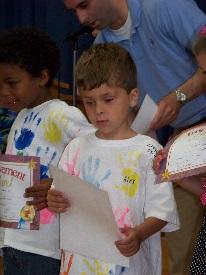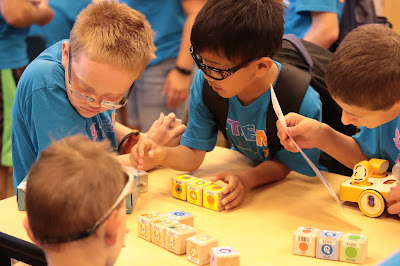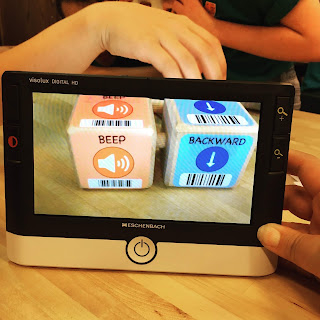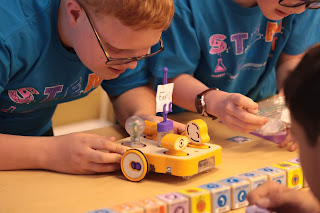My thoughts: I CANNOT believe that this is a post about Jimmy eh um...Jim going to high school! I still remember him as my preschool student. Where has the time gone? I've loved staying with him and his mom, Kristi as they take on new adventures together. I can't wait to see what lies ahead for the both of them.
Hello everyone! It has been a while since we have chatted. It is September 2018 and we all know what that means, the beginning of the school year for most. We have left behind Elementary School and Middle School/Junior High and now it is time for Jimmy to start his last school at home, ie. High school!!! With every transitional school year it doesn’t come without its challenges. This year we have had more than I have seen before with Jimmy. To start the first week of school were all half days due to extreme heat which also means he was not given a chance to get his bearings around school nor get used to his schedule, nor his teachers/administration had a chance to get to know him, so for all us parents of our blind students who are transitioning it means EVEN MORE HEADACHES.
As I sit here I don’t even know where to begin: classes, teachers, over protective administration who are comparing Jimmy to past students or the fact that Jimmy is in HIGH School. Let’s start with the fact Jimmy is 100% a teenage AND a high school student. And no matter what is said or asked of, or even reminding him to get his school work done we get an attitude for it. For the past 9 years I have been dreading this school year for no reason other than knowing that once THESE four years are over my only son is off to college and it is the beginning of his adult life. I truly am not going to dwell on the college years as I do have 4 more years to get through as most of us remember our high school experiences so we will have a lot more going on socially than ever before. Jimmy plans on wrestling for the school this coming winter which will be something new for him but hey he loves a good challenge.
 |
| A picture of Jimmy as a preschooler |
As we are only a week or so into school it has bee a ball of fun (insert sarcasm here) as Jimmy was NOT given a brailled schedule the first day of school nor have any teachers (that I am aware of) given him any brailled work, which means they haven’t given any to his braillist. He has already been given zeros on assignments because those assignments were uploaded to Google Classroom which he currently doesn’t have access to. (yes an email was sent out to address this after it was brought to my attention) One amazing thing though is that Jimmy has finally truly embraced his laptop and wants to do most of his work through this technology but with that being said we are already seeing difficulty accessing email, getting work sent to him, and then him back to the teachers but as with all transitions this will get worked out sooner than later. Due to all of the half days (we had a heat wave the first week and a half of school) the staffing meeting we had, had to be rescheduled, at which time we planned to go over all areas of concern the teachers MAY have as we are tackling a new school. The meeting was scheduled for more than a week later so thus we couldn’t get some of the challenges out of the way. This means the teachers had no idea how to get him his work or how he is going to his work back to them. This really puts a damper on not having any hurdles to get over because all we have at this point are hurdles.
As I haven’t had a chance to meet the teachers face to face only ONE teacher has reached out to me since the beginning of school to introduce themselves to me and give me a quick rundown on what is expected, if I have any concerns and that this teacher is excited to have jimmy in their classroom, the two even spent about an hour after school one day just talking getting to know one another. (Bonus points to this teacher).
Jimmy was lucky enough to have a couple trips to school over the course of the summer to tour, walk, get to know his environment the best he could with no other students but even with this additional time he still found a way to walk into a display case. You may be asking if he was using appropriate cane skills to which the answer is yes, but the problem is/was that this particular display case is hanging on the wall with nothing below to allow his cane to indicate to him that there is something sticking a foot and half out from the wall until he found it with his face. He is fine and he went on about his day but the problem we faced was a friend saw it and reported it to the Principal. I know this was done out of concern for Jimmy to not get hurt but it caused the school to go on hyper drive over liability and claim that Jimmy needs to be observed. As I came to find out that there were a couple more safety concerns because I am allowing Jimmy to walk through the parking lot and walk home. At the school we have a couple of over protective staff members who claim that Jimmy was in danger of getting hit by a car (which was not the case AT ALL) but now Jimmy has to be shadowed for the next 2 weeks to make sure that he is safe. If Jimmy was not safe all the appropriate people, in particular his O&M teacher, would not have signed off on him walking.
Ok so let me back up a little bit, Jimmy’s TVI and I have been in lots of contact through this process and she did give me the heads up that the school was thinking about having Jimmy shadowed for a little while to just make sure he has his classes down and everything is good. His TVI told the administration to please contact Mom to discuss it with her prior to starting any shadowing of Jimmy. I bet you all can guess what didn’t happen, that’s right I did not get a call and again found out after the fact of this happening. Can anyone take a guess as to what happened next? That is right I marched right down to the school to have a face to face with Jimmy’s administrator. I am not going to allow my son’s independence be taken away that quickly with only 4 cumulative days at school.
As this is a new school the administration did not know me yet, but they do now!!! I have to say that the discussion I had with Jimmy’s administrator did go well, we both had a chance to speak about the who’s, when’s, why’s and now they are aware that if things happen behind my back and I find out about it, I am not going to just make a phone call they are going to see my face and we are going to talk right then and there. The one funny part to the conversation (at least to me) was when said administrator said that they want to be able to put my fear to rest which I then interrupted them and explained that this was not fear I had but straight anger for what was happening without my involvement. It was at this point I had to start educating them. When asked if I heard about him hitting his nose I said yes because my child talks to me about that. And the next question/statement was well he was asked to go to the nurse and he turned it down. I said yes I know, he turned it down because he was fine. I then pointedly asked the administrator if it was a sighted student who wasn’t paying attention and hit this thing and said they were fine, would everyone be up in arms? Their reply, no probably not, so for my child because he is blind we are not going to listen to his words of him being fine? Administrator saw my point and said you right we have to listen to what he is saying and not think he doesn’t know himself well enough to state weather he is ok or not. Furthermore they are already comparing him to another.
 |
| A picture of Jimmy on his first day of high school with a female friend. |
You see another blind student just graduated at the end of last year, so the school has had a blind student so recently that one would have assumed they would give this NEW blind student a chance to get acclimated to the school. And from what Jimmy was telling me they (the staff) are already comparing my child to this child. I feel as a parent of a blind child it is part of my job to educate the sighted world as to the fact that no two blind children are the same just like no other two people (no matter the circumstances) are alike. It has been my experience that as soon as the word blind, or deaf, or disabled are used people have a preconceived notion that two individuals with the same dis-abil(able)-ity (see what I did there, the word able is in the word disability and they have to recognize that are children are still able to do things) are the exact same, but in actuality that does not mean that those two children have the same skills, personalities, or even the same acceptance to where the cards they have been dealt. My child and this other child are complete polar opposites that any two kids can be. And it is really frustrating to have to explain, yet again, that the staff has to look past the blindness of these two students and look at the student. When all of this was discussed with the administrator they said well I already see the differences between the two and Jimmy’s teachers will as well. I was like that is all good and fine but what about the rest of the staff who does NOT have interaction with my child but instead just assumes he is like the other boy. Everyone has to be told to have an open mind in regards to the different children.
As Jimmy is now in high school he has to continue to speak up for himself which he does very well. This time he asked me to start the conversation as he sincerely didn’t know who to go talk to. The administrator I spoke with did pull Jimmy aside the following day to have a conversation about all the goings on and they were able to have an open and honest conversation about it all. Jimmy got to convey his perspective on how things are going and to speak towards the “incidences” and the administrator also took what Jimmy had to say to heart. Jimmy is and will be fully involved in his education and things he like and doesn’t like. If he feels there is something that can be changed and will be hands on.
I know it can at times seem that the schools, administrators, or even the teachers don’t get our kids but that is why I will always be outspoken with them and try to get them to be open and understanding that our kids are just that kids who have the right to be independent and left alone to enjoy school like all the sighted kids. Are they “different” I guess you can say that but that doesn’t mean that they are less-than anyone else if nothing else they are more-than because they have had to face a harder life and continuously have to Prove themselves to everyone around them that they ARE just like everyone else. They are students who are just trying to navigate growing up like everyone else and if that means I have to be momma bear at times to get people who don’t know my child well to understand to back off and let him be, than by George that is exactly what I am going to do.
It is hard to be a parent of a blind student, especially when you enter a new school and have teach them all what said child is capable of. This does not happen with sighted students only with students who have an IEP, 504, whatever the case. We (or at least I) want to just scream in their face to back the #&( up and let my kid be. He can handle himself and if he can’t he will be the first one to ask for help or guidance. I want to scream to give him more than 3 days to get used to his school and show you who and what he is. I want to scream he is a typical 9th grader who doesn’t want to be treated any different than any other child in the school. Please give him room to grow and be comfortable in his own skin, do have a preconceived idea of who or what he is. Take a minute and talk to him (this part goes for the other students too who just see someone different and assume they know what he is like) isn’t that why you went into teaching to help and teach our children to be the best version of themselves and give them a chance to become productive humans in this world we live in? STOP ASSUMING and take a minute to learn.
Come Tuesday we will be starting our second week at our new school where we have both Open House and the Staffing meeting. My hopes are I meet everyone at the Open House and then the staffing meeting will be a breeze and I will not be fighting will all the teachers on who’s, what’s, where’s, and how’s. Hopefully they will be open and willing to do things just a little different to make sure that Jim is included in all areas of the classroom because if not we will be seeing each other real soon and after that meeting Jimmy will be included through modifications that I will do my best to give them if not I have a wonderful support group (TVI’s, past ECC instructors, and other families) to go to help give me ideas on how to best help the class and Jimmy. So for now so long and keep your fingers crossed that everything will be worked out within the next week and I will never have to think about it again. (I know it’s kind of a pipe dream, but a mom can hope for this Right!?)
















































